In-Depth Analysis: Principles and Practice of Assessment Unit 1
VerifiedAdded on 2023/05/30
|20
|5771
|139
Essay
AI Summary
This essay provides a comprehensive overview of the principles and practices of assessment in education. It begins by explaining the function of assessment in learning and development, covering initial, formative, and summative assessments. The essay defines key concepts such as validity, reliability, authenticity, and transparency, emphasizing the responsibilities of the assessor in planning, communicating, and conducting assessments, as well as providing feedback. It identifies relevant regulations like the Data Protection Act and Equality Act, and compares various assessment methods like work products, simulations, written assessments, and observations, highlighting their strengths and limitations. Furthermore, the essay summarizes key factors to consider when planning assessments, such as learner readiness and timing, and evaluates the benefits of using a holistic approach to assessment, detailing the steps to plan such an approach. The essay concludes by emphasizing the importance of aligning assessment with learning outcomes and regulatory requirements.
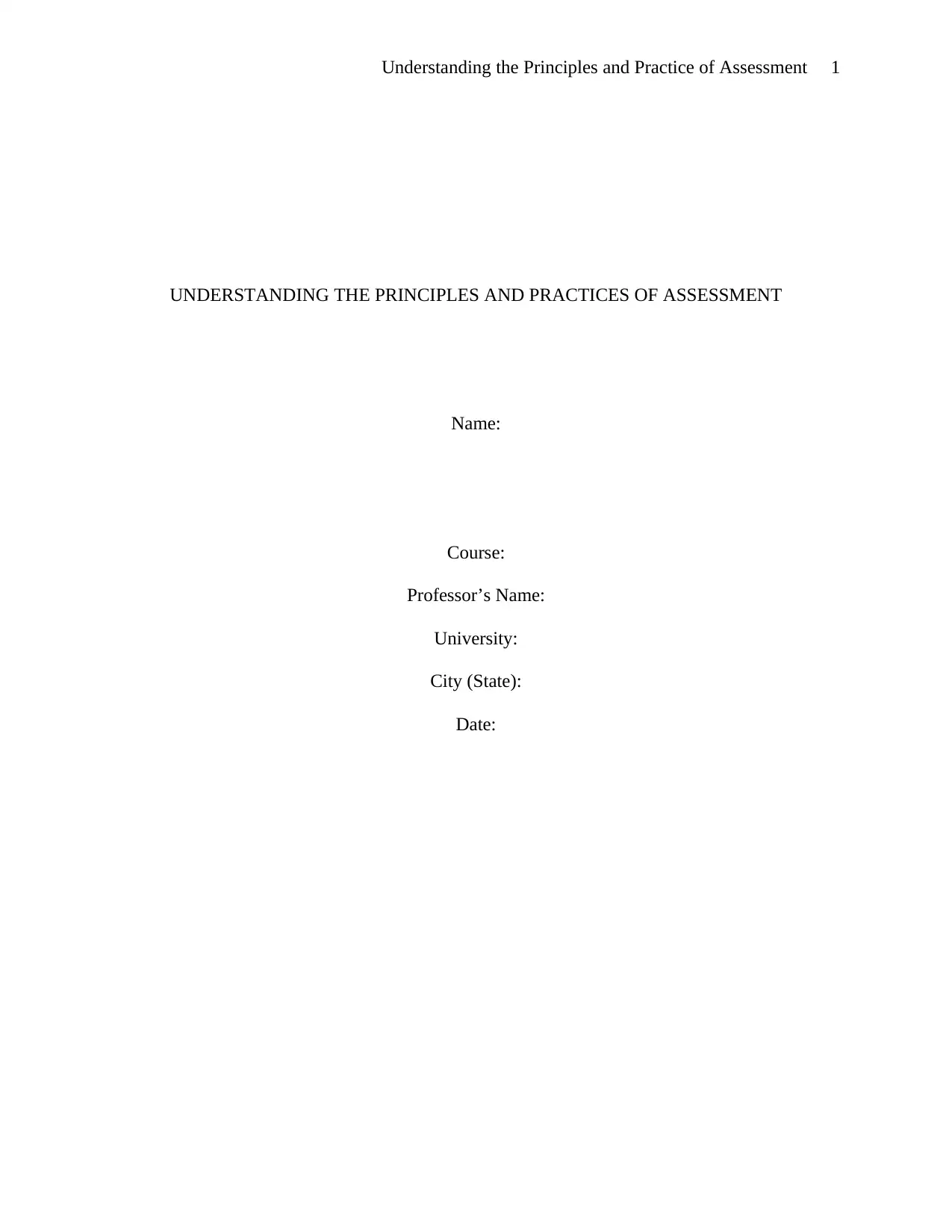
Understanding the Principles and Practice of Assessment 1
UNDERSTANDING THE PRINCIPLES AND PRACTICES OF ASSESSMENT
Name:
Course:
Professor’s Name:
University:
City (State):
Date:
UNDERSTANDING THE PRINCIPLES AND PRACTICES OF ASSESSMENT
Name:
Course:
Professor’s Name:
University:
City (State):
Date:
Paraphrase This Document
Need a fresh take? Get an instant paraphrase of this document with our AI Paraphraser
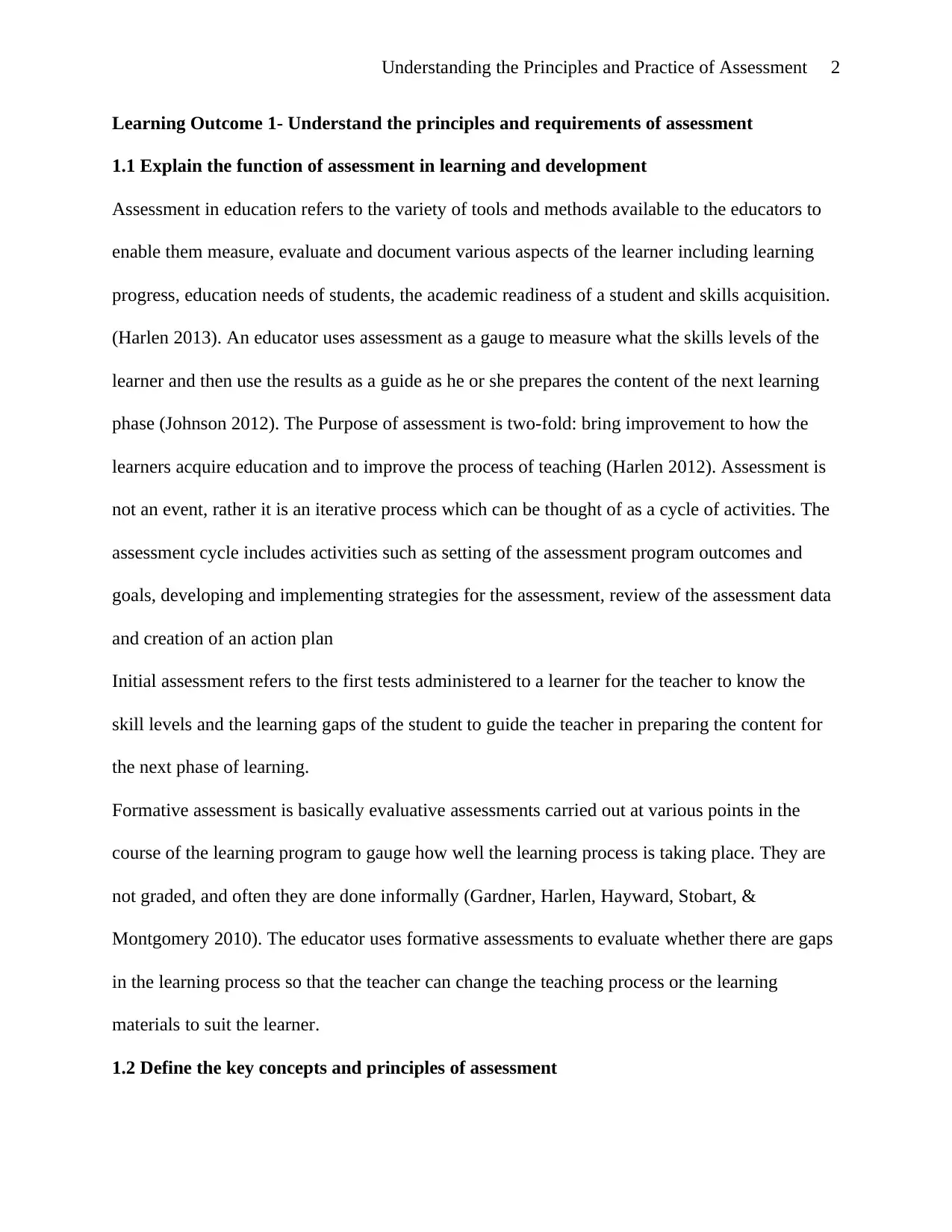
Understanding the Principles and Practice of Assessment 2
Learning Outcome 1- Understand the principles and requirements of assessment
1.1 Explain the function of assessment in learning and development
Assessment in education refers to the variety of tools and methods available to the educators to
enable them measure, evaluate and document various aspects of the learner including learning
progress, education needs of students, the academic readiness of a student and skills acquisition.
(Harlen 2013). An educator uses assessment as a gauge to measure what the skills levels of the
learner and then use the results as a guide as he or she prepares the content of the next learning
phase (Johnson 2012). The Purpose of assessment is two-fold: bring improvement to how the
learners acquire education and to improve the process of teaching (Harlen 2012). Assessment is
not an event, rather it is an iterative process which can be thought of as a cycle of activities. The
assessment cycle includes activities such as setting of the assessment program outcomes and
goals, developing and implementing strategies for the assessment, review of the assessment data
and creation of an action plan
Initial assessment refers to the first tests administered to a learner for the teacher to know the
skill levels and the learning gaps of the student to guide the teacher in preparing the content for
the next phase of learning.
Formative assessment is basically evaluative assessments carried out at various points in the
course of the learning program to gauge how well the learning process is taking place. They are
not graded, and often they are done informally (Gardner, Harlen, Hayward, Stobart, &
Montgomery 2010). The educator uses formative assessments to evaluate whether there are gaps
in the learning process so that the teacher can change the teaching process or the learning
materials to suit the learner.
1.2 Define the key concepts and principles of assessment
Learning Outcome 1- Understand the principles and requirements of assessment
1.1 Explain the function of assessment in learning and development
Assessment in education refers to the variety of tools and methods available to the educators to
enable them measure, evaluate and document various aspects of the learner including learning
progress, education needs of students, the academic readiness of a student and skills acquisition.
(Harlen 2013). An educator uses assessment as a gauge to measure what the skills levels of the
learner and then use the results as a guide as he or she prepares the content of the next learning
phase (Johnson 2012). The Purpose of assessment is two-fold: bring improvement to how the
learners acquire education and to improve the process of teaching (Harlen 2012). Assessment is
not an event, rather it is an iterative process which can be thought of as a cycle of activities. The
assessment cycle includes activities such as setting of the assessment program outcomes and
goals, developing and implementing strategies for the assessment, review of the assessment data
and creation of an action plan
Initial assessment refers to the first tests administered to a learner for the teacher to know the
skill levels and the learning gaps of the student to guide the teacher in preparing the content for
the next phase of learning.
Formative assessment is basically evaluative assessments carried out at various points in the
course of the learning program to gauge how well the learning process is taking place. They are
not graded, and often they are done informally (Gardner, Harlen, Hayward, Stobart, &
Montgomery 2010). The educator uses formative assessments to evaluate whether there are gaps
in the learning process so that the teacher can change the teaching process or the learning
materials to suit the learner.
1.2 Define the key concepts and principles of assessment
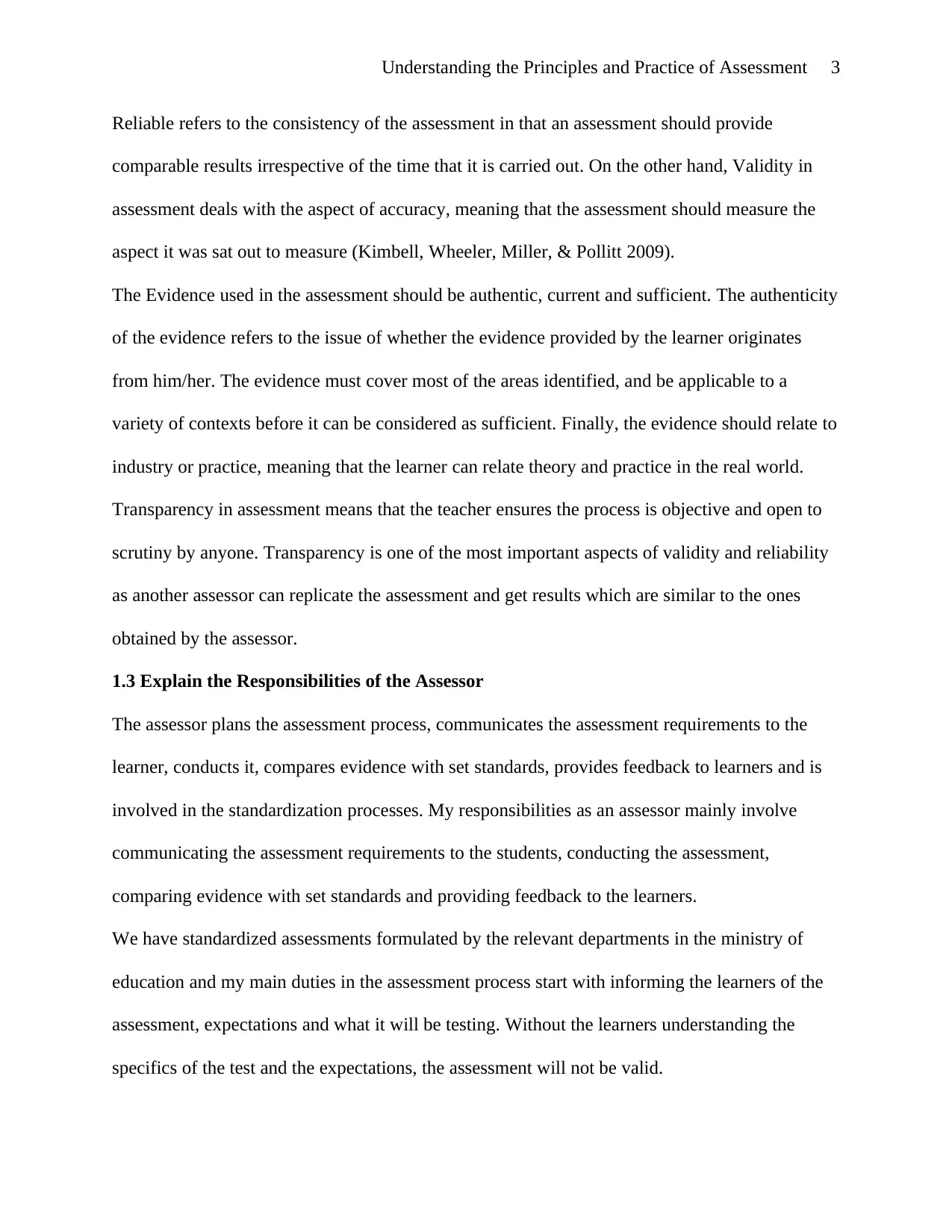
Understanding the Principles and Practice of Assessment 3
Reliable refers to the consistency of the assessment in that an assessment should provide
comparable results irrespective of the time that it is carried out. On the other hand, Validity in
assessment deals with the aspect of accuracy, meaning that the assessment should measure the
aspect it was sat out to measure (Kimbell, Wheeler, Miller, & Pollitt 2009).
The Evidence used in the assessment should be authentic, current and sufficient. The authenticity
of the evidence refers to the issue of whether the evidence provided by the learner originates
from him/her. The evidence must cover most of the areas identified, and be applicable to a
variety of contexts before it can be considered as sufficient. Finally, the evidence should relate to
industry or practice, meaning that the learner can relate theory and practice in the real world.
Transparency in assessment means that the teacher ensures the process is objective and open to
scrutiny by anyone. Transparency is one of the most important aspects of validity and reliability
as another assessor can replicate the assessment and get results which are similar to the ones
obtained by the assessor.
1.3 Explain the Responsibilities of the Assessor
The assessor plans the assessment process, communicates the assessment requirements to the
learner, conducts it, compares evidence with set standards, provides feedback to learners and is
involved in the standardization processes. My responsibilities as an assessor mainly involve
communicating the assessment requirements to the students, conducting the assessment,
comparing evidence with set standards and providing feedback to the learners.
We have standardized assessments formulated by the relevant departments in the ministry of
education and my main duties in the assessment process start with informing the learners of the
assessment, expectations and what it will be testing. Without the learners understanding the
specifics of the test and the expectations, the assessment will not be valid.
Reliable refers to the consistency of the assessment in that an assessment should provide
comparable results irrespective of the time that it is carried out. On the other hand, Validity in
assessment deals with the aspect of accuracy, meaning that the assessment should measure the
aspect it was sat out to measure (Kimbell, Wheeler, Miller, & Pollitt 2009).
The Evidence used in the assessment should be authentic, current and sufficient. The authenticity
of the evidence refers to the issue of whether the evidence provided by the learner originates
from him/her. The evidence must cover most of the areas identified, and be applicable to a
variety of contexts before it can be considered as sufficient. Finally, the evidence should relate to
industry or practice, meaning that the learner can relate theory and practice in the real world.
Transparency in assessment means that the teacher ensures the process is objective and open to
scrutiny by anyone. Transparency is one of the most important aspects of validity and reliability
as another assessor can replicate the assessment and get results which are similar to the ones
obtained by the assessor.
1.3 Explain the Responsibilities of the Assessor
The assessor plans the assessment process, communicates the assessment requirements to the
learner, conducts it, compares evidence with set standards, provides feedback to learners and is
involved in the standardization processes. My responsibilities as an assessor mainly involve
communicating the assessment requirements to the students, conducting the assessment,
comparing evidence with set standards and providing feedback to the learners.
We have standardized assessments formulated by the relevant departments in the ministry of
education and my main duties in the assessment process start with informing the learners of the
assessment, expectations and what it will be testing. Without the learners understanding the
specifics of the test and the expectations, the assessment will not be valid.
⊘ This is a preview!⊘
Do you want full access?
Subscribe today to unlock all pages.

Trusted by 1+ million students worldwide
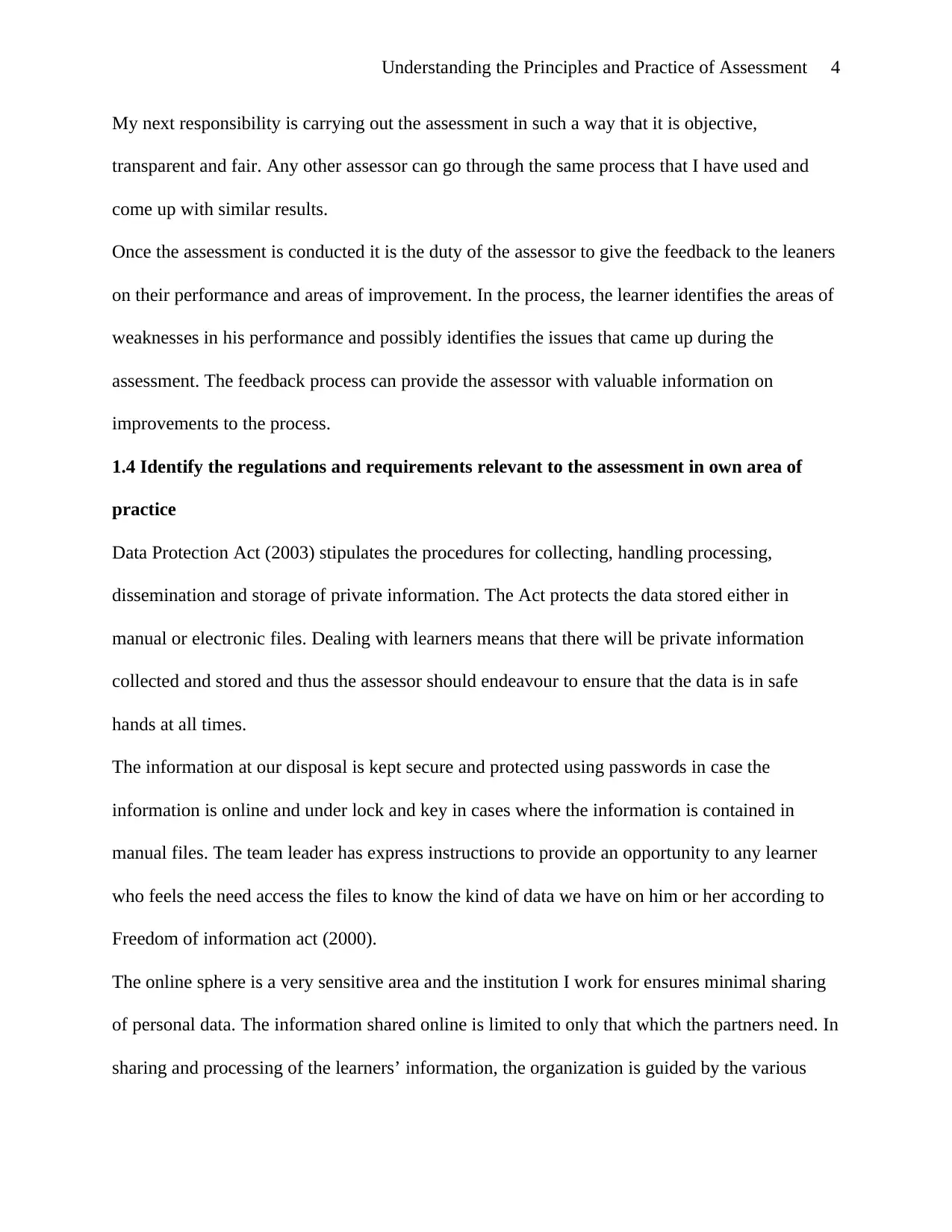
Understanding the Principles and Practice of Assessment 4
My next responsibility is carrying out the assessment in such a way that it is objective,
transparent and fair. Any other assessor can go through the same process that I have used and
come up with similar results.
Once the assessment is conducted it is the duty of the assessor to give the feedback to the leaners
on their performance and areas of improvement. In the process, the learner identifies the areas of
weaknesses in his performance and possibly identifies the issues that came up during the
assessment. The feedback process can provide the assessor with valuable information on
improvements to the process.
1.4 Identify the regulations and requirements relevant to the assessment in own area of
practice
Data Protection Act (2003) stipulates the procedures for collecting, handling processing,
dissemination and storage of private information. The Act protects the data stored either in
manual or electronic files. Dealing with learners means that there will be private information
collected and stored and thus the assessor should endeavour to ensure that the data is in safe
hands at all times.
The information at our disposal is kept secure and protected using passwords in case the
information is online and under lock and key in cases where the information is contained in
manual files. The team leader has express instructions to provide an opportunity to any learner
who feels the need access the files to know the kind of data we have on him or her according to
Freedom of information act (2000).
The online sphere is a very sensitive area and the institution I work for ensures minimal sharing
of personal data. The information shared online is limited to only that which the partners need. In
sharing and processing of the learners’ information, the organization is guided by the various
My next responsibility is carrying out the assessment in such a way that it is objective,
transparent and fair. Any other assessor can go through the same process that I have used and
come up with similar results.
Once the assessment is conducted it is the duty of the assessor to give the feedback to the leaners
on their performance and areas of improvement. In the process, the learner identifies the areas of
weaknesses in his performance and possibly identifies the issues that came up during the
assessment. The feedback process can provide the assessor with valuable information on
improvements to the process.
1.4 Identify the regulations and requirements relevant to the assessment in own area of
practice
Data Protection Act (2003) stipulates the procedures for collecting, handling processing,
dissemination and storage of private information. The Act protects the data stored either in
manual or electronic files. Dealing with learners means that there will be private information
collected and stored and thus the assessor should endeavour to ensure that the data is in safe
hands at all times.
The information at our disposal is kept secure and protected using passwords in case the
information is online and under lock and key in cases where the information is contained in
manual files. The team leader has express instructions to provide an opportunity to any learner
who feels the need access the files to know the kind of data we have on him or her according to
Freedom of information act (2000).
The online sphere is a very sensitive area and the institution I work for ensures minimal sharing
of personal data. The information shared online is limited to only that which the partners need. In
sharing and processing of the learners’ information, the organization is guided by the various
Paraphrase This Document
Need a fresh take? Get an instant paraphrase of this document with our AI Paraphraser
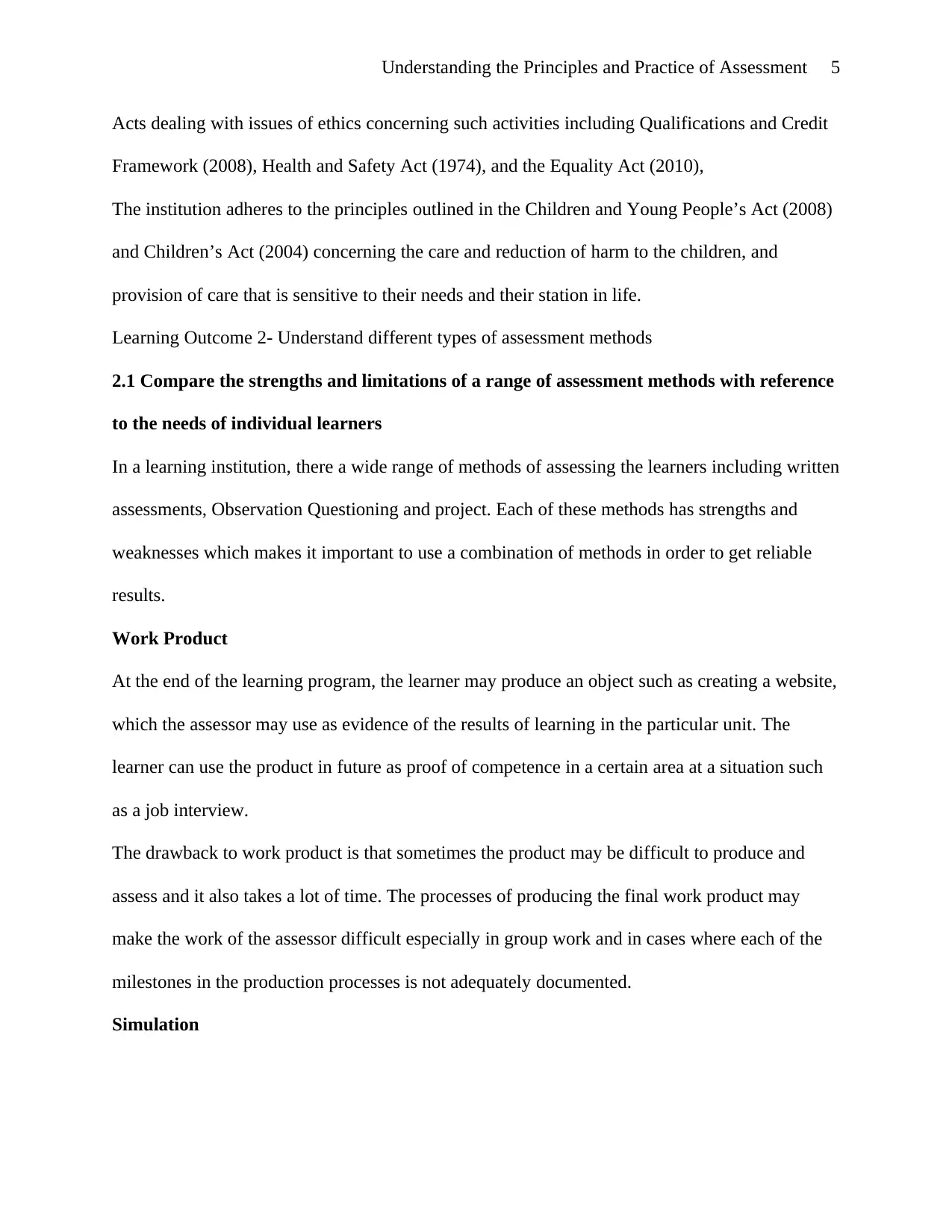
Understanding the Principles and Practice of Assessment 5
Acts dealing with issues of ethics concerning such activities including Qualifications and Credit
Framework (2008), Health and Safety Act (1974), and the Equality Act (2010),
The institution adheres to the principles outlined in the Children and Young People’s Act (2008)
and Children’s Act (2004) concerning the care and reduction of harm to the children, and
provision of care that is sensitive to their needs and their station in life.
Learning Outcome 2- Understand different types of assessment methods
2.1 Compare the strengths and limitations of a range of assessment methods with reference
to the needs of individual learners
In a learning institution, there a wide range of methods of assessing the learners including written
assessments, Observation Questioning and project. Each of these methods has strengths and
weaknesses which makes it important to use a combination of methods in order to get reliable
results.
Work Product
At the end of the learning program, the learner may produce an object such as creating a website,
which the assessor may use as evidence of the results of learning in the particular unit. The
learner can use the product in future as proof of competence in a certain area at a situation such
as a job interview.
The drawback to work product is that sometimes the product may be difficult to produce and
assess and it also takes a lot of time. The processes of producing the final work product may
make the work of the assessor difficult especially in group work and in cases where each of the
milestones in the production processes is not adequately documented.
Simulation
Acts dealing with issues of ethics concerning such activities including Qualifications and Credit
Framework (2008), Health and Safety Act (1974), and the Equality Act (2010),
The institution adheres to the principles outlined in the Children and Young People’s Act (2008)
and Children’s Act (2004) concerning the care and reduction of harm to the children, and
provision of care that is sensitive to their needs and their station in life.
Learning Outcome 2- Understand different types of assessment methods
2.1 Compare the strengths and limitations of a range of assessment methods with reference
to the needs of individual learners
In a learning institution, there a wide range of methods of assessing the learners including written
assessments, Observation Questioning and project. Each of these methods has strengths and
weaknesses which makes it important to use a combination of methods in order to get reliable
results.
Work Product
At the end of the learning program, the learner may produce an object such as creating a website,
which the assessor may use as evidence of the results of learning in the particular unit. The
learner can use the product in future as proof of competence in a certain area at a situation such
as a job interview.
The drawback to work product is that sometimes the product may be difficult to produce and
assess and it also takes a lot of time. The processes of producing the final work product may
make the work of the assessor difficult especially in group work and in cases where each of the
milestones in the production processes is not adequately documented.
Simulation
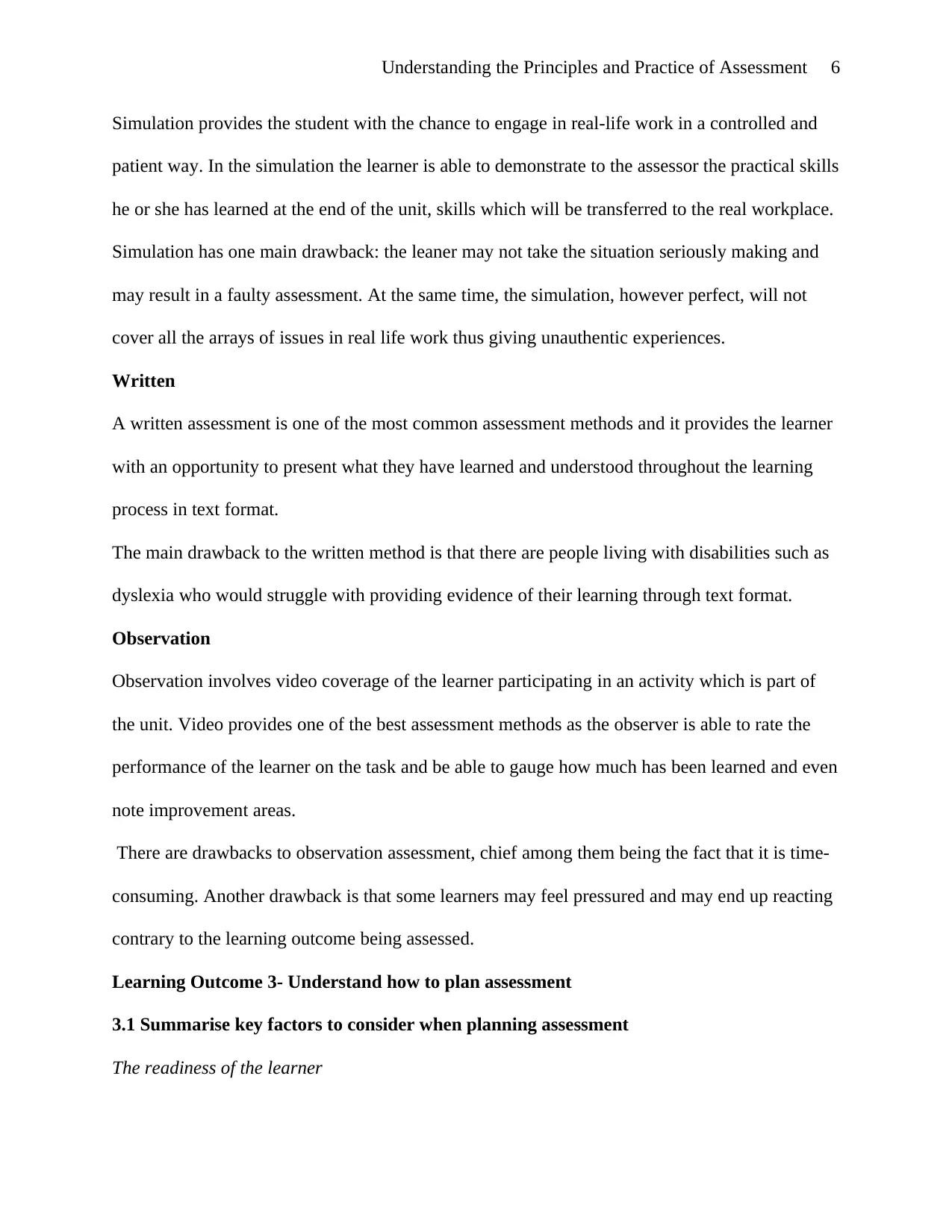
Understanding the Principles and Practice of Assessment 6
Simulation provides the student with the chance to engage in real-life work in a controlled and
patient way. In the simulation the learner is able to demonstrate to the assessor the practical skills
he or she has learned at the end of the unit, skills which will be transferred to the real workplace.
Simulation has one main drawback: the leaner may not take the situation seriously making and
may result in a faulty assessment. At the same time, the simulation, however perfect, will not
cover all the arrays of issues in real life work thus giving unauthentic experiences.
Written
A written assessment is one of the most common assessment methods and it provides the learner
with an opportunity to present what they have learned and understood throughout the learning
process in text format.
The main drawback to the written method is that there are people living with disabilities such as
dyslexia who would struggle with providing evidence of their learning through text format.
Observation
Observation involves video coverage of the learner participating in an activity which is part of
the unit. Video provides one of the best assessment methods as the observer is able to rate the
performance of the learner on the task and be able to gauge how much has been learned and even
note improvement areas.
There are drawbacks to observation assessment, chief among them being the fact that it is time-
consuming. Another drawback is that some learners may feel pressured and may end up reacting
contrary to the learning outcome being assessed.
Learning Outcome 3- Understand how to plan assessment
3.1 Summarise key factors to consider when planning assessment
The readiness of the learner
Simulation provides the student with the chance to engage in real-life work in a controlled and
patient way. In the simulation the learner is able to demonstrate to the assessor the practical skills
he or she has learned at the end of the unit, skills which will be transferred to the real workplace.
Simulation has one main drawback: the leaner may not take the situation seriously making and
may result in a faulty assessment. At the same time, the simulation, however perfect, will not
cover all the arrays of issues in real life work thus giving unauthentic experiences.
Written
A written assessment is one of the most common assessment methods and it provides the learner
with an opportunity to present what they have learned and understood throughout the learning
process in text format.
The main drawback to the written method is that there are people living with disabilities such as
dyslexia who would struggle with providing evidence of their learning through text format.
Observation
Observation involves video coverage of the learner participating in an activity which is part of
the unit. Video provides one of the best assessment methods as the observer is able to rate the
performance of the learner on the task and be able to gauge how much has been learned and even
note improvement areas.
There are drawbacks to observation assessment, chief among them being the fact that it is time-
consuming. Another drawback is that some learners may feel pressured and may end up reacting
contrary to the learning outcome being assessed.
Learning Outcome 3- Understand how to plan assessment
3.1 Summarise key factors to consider when planning assessment
The readiness of the learner
⊘ This is a preview!⊘
Do you want full access?
Subscribe today to unlock all pages.

Trusted by 1+ million students worldwide
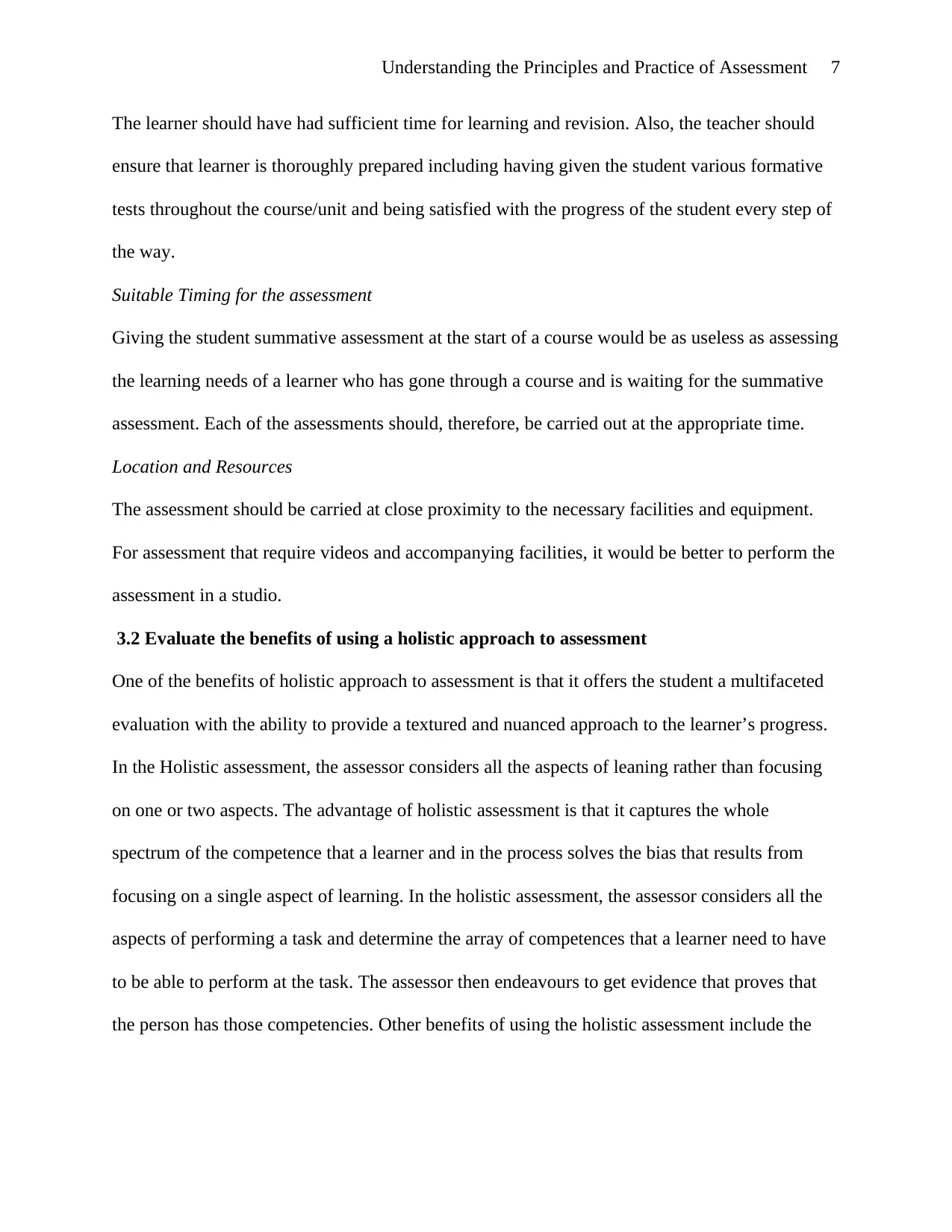
Understanding the Principles and Practice of Assessment 7
The learner should have had sufficient time for learning and revision. Also, the teacher should
ensure that learner is thoroughly prepared including having given the student various formative
tests throughout the course/unit and being satisfied with the progress of the student every step of
the way.
Suitable Timing for the assessment
Giving the student summative assessment at the start of a course would be as useless as assessing
the learning needs of a learner who has gone through a course and is waiting for the summative
assessment. Each of the assessments should, therefore, be carried out at the appropriate time.
Location and Resources
The assessment should be carried at close proximity to the necessary facilities and equipment.
For assessment that require videos and accompanying facilities, it would be better to perform the
assessment in a studio.
3.2 Evaluate the benefits of using a holistic approach to assessment
One of the benefits of holistic approach to assessment is that it offers the student a multifaceted
evaluation with the ability to provide a textured and nuanced approach to the learner’s progress.
In the Holistic assessment, the assessor considers all the aspects of leaning rather than focusing
on one or two aspects. The advantage of holistic assessment is that it captures the whole
spectrum of the competence that a learner and in the process solves the bias that results from
focusing on a single aspect of learning. In the holistic assessment, the assessor considers all the
aspects of performing a task and determine the array of competences that a learner need to have
to be able to perform at the task. The assessor then endeavours to get evidence that proves that
the person has those competencies. Other benefits of using the holistic assessment include the
The learner should have had sufficient time for learning and revision. Also, the teacher should
ensure that learner is thoroughly prepared including having given the student various formative
tests throughout the course/unit and being satisfied with the progress of the student every step of
the way.
Suitable Timing for the assessment
Giving the student summative assessment at the start of a course would be as useless as assessing
the learning needs of a learner who has gone through a course and is waiting for the summative
assessment. Each of the assessments should, therefore, be carried out at the appropriate time.
Location and Resources
The assessment should be carried at close proximity to the necessary facilities and equipment.
For assessment that require videos and accompanying facilities, it would be better to perform the
assessment in a studio.
3.2 Evaluate the benefits of using a holistic approach to assessment
One of the benefits of holistic approach to assessment is that it offers the student a multifaceted
evaluation with the ability to provide a textured and nuanced approach to the learner’s progress.
In the Holistic assessment, the assessor considers all the aspects of leaning rather than focusing
on one or two aspects. The advantage of holistic assessment is that it captures the whole
spectrum of the competence that a learner and in the process solves the bias that results from
focusing on a single aspect of learning. In the holistic assessment, the assessor considers all the
aspects of performing a task and determine the array of competences that a learner need to have
to be able to perform at the task. The assessor then endeavours to get evidence that proves that
the person has those competencies. Other benefits of using the holistic assessment include the
Paraphrase This Document
Need a fresh take? Get an instant paraphrase of this document with our AI Paraphraser
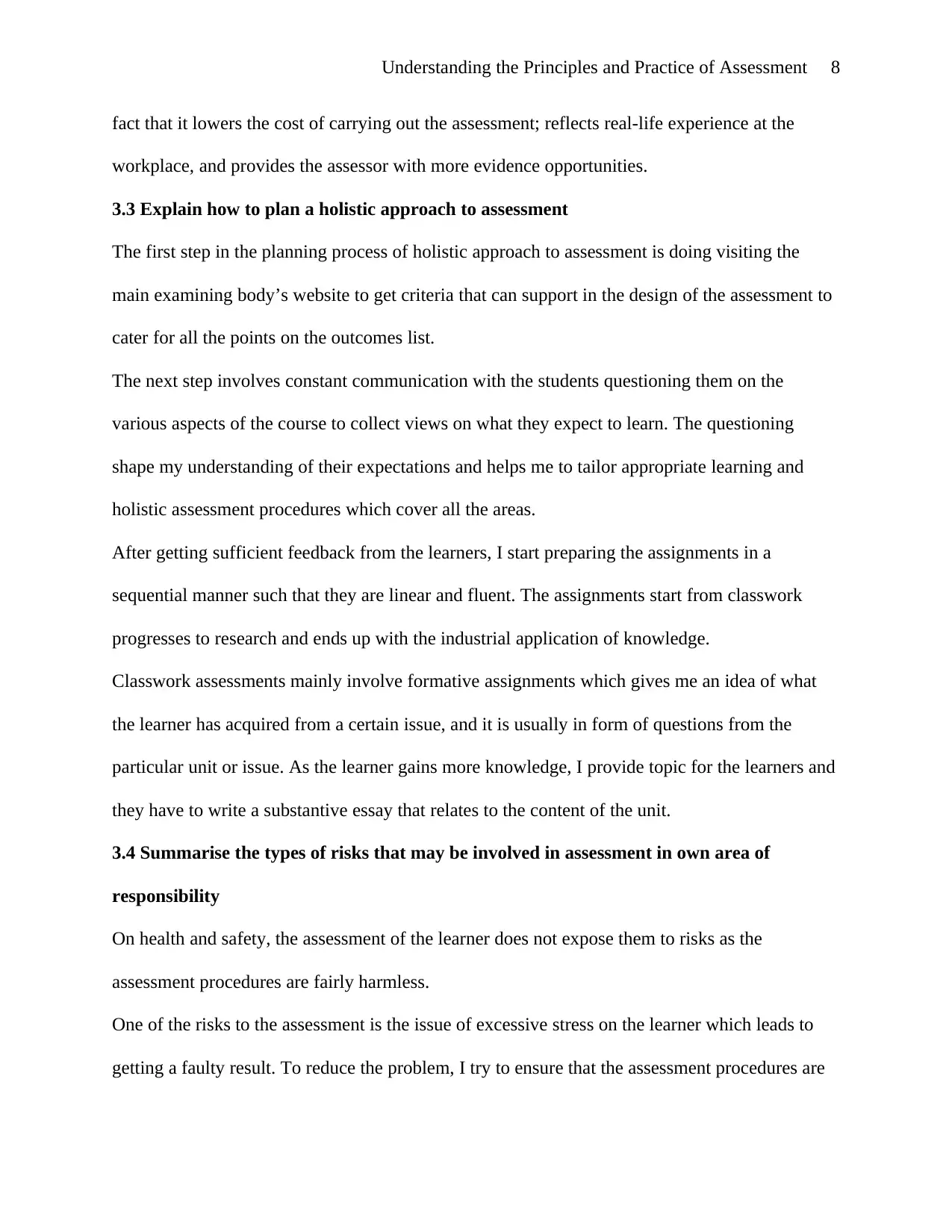
Understanding the Principles and Practice of Assessment 8
fact that it lowers the cost of carrying out the assessment; reflects real-life experience at the
workplace, and provides the assessor with more evidence opportunities.
3.3 Explain how to plan a holistic approach to assessment
The first step in the planning process of holistic approach to assessment is doing visiting the
main examining body’s website to get criteria that can support in the design of the assessment to
cater for all the points on the outcomes list.
The next step involves constant communication with the students questioning them on the
various aspects of the course to collect views on what they expect to learn. The questioning
shape my understanding of their expectations and helps me to tailor appropriate learning and
holistic assessment procedures which cover all the areas.
After getting sufficient feedback from the learners, I start preparing the assignments in a
sequential manner such that they are linear and fluent. The assignments start from classwork
progresses to research and ends up with the industrial application of knowledge.
Classwork assessments mainly involve formative assignments which gives me an idea of what
the learner has acquired from a certain issue, and it is usually in form of questions from the
particular unit or issue. As the learner gains more knowledge, I provide topic for the learners and
they have to write a substantive essay that relates to the content of the unit.
3.4 Summarise the types of risks that may be involved in assessment in own area of
responsibility
On health and safety, the assessment of the learner does not expose them to risks as the
assessment procedures are fairly harmless.
One of the risks to the assessment is the issue of excessive stress on the learner which leads to
getting a faulty result. To reduce the problem, I try to ensure that the assessment procedures are
fact that it lowers the cost of carrying out the assessment; reflects real-life experience at the
workplace, and provides the assessor with more evidence opportunities.
3.3 Explain how to plan a holistic approach to assessment
The first step in the planning process of holistic approach to assessment is doing visiting the
main examining body’s website to get criteria that can support in the design of the assessment to
cater for all the points on the outcomes list.
The next step involves constant communication with the students questioning them on the
various aspects of the course to collect views on what they expect to learn. The questioning
shape my understanding of their expectations and helps me to tailor appropriate learning and
holistic assessment procedures which cover all the areas.
After getting sufficient feedback from the learners, I start preparing the assignments in a
sequential manner such that they are linear and fluent. The assignments start from classwork
progresses to research and ends up with the industrial application of knowledge.
Classwork assessments mainly involve formative assignments which gives me an idea of what
the learner has acquired from a certain issue, and it is usually in form of questions from the
particular unit or issue. As the learner gains more knowledge, I provide topic for the learners and
they have to write a substantive essay that relates to the content of the unit.
3.4 Summarise the types of risks that may be involved in assessment in own area of
responsibility
On health and safety, the assessment of the learner does not expose them to risks as the
assessment procedures are fairly harmless.
One of the risks to the assessment is the issue of excessive stress on the learner which leads to
getting a faulty result. To reduce the problem, I try to ensure that the assessment procedures are
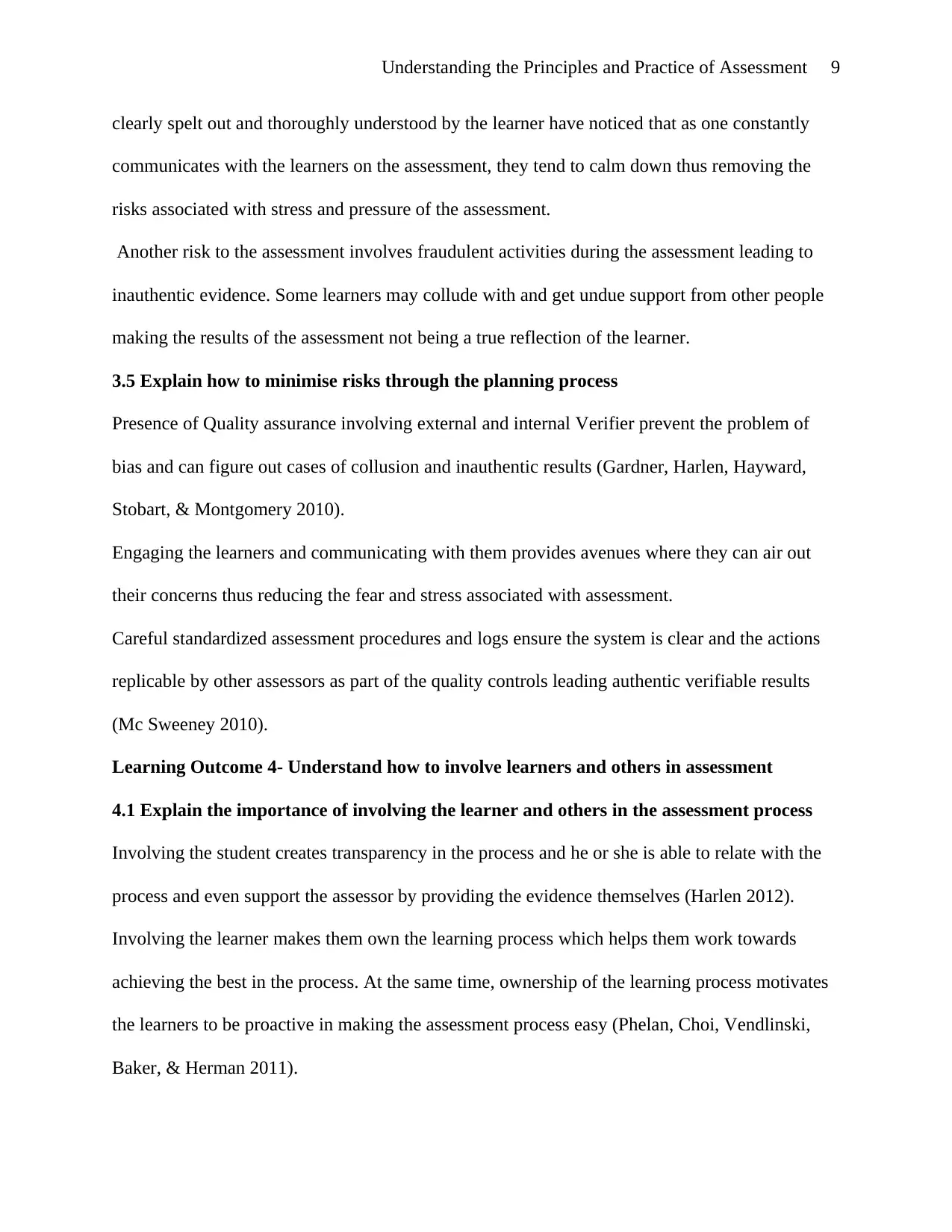
Understanding the Principles and Practice of Assessment 9
clearly spelt out and thoroughly understood by the learner have noticed that as one constantly
communicates with the learners on the assessment, they tend to calm down thus removing the
risks associated with stress and pressure of the assessment.
Another risk to the assessment involves fraudulent activities during the assessment leading to
inauthentic evidence. Some learners may collude with and get undue support from other people
making the results of the assessment not being a true reflection of the learner.
3.5 Explain how to minimise risks through the planning process
Presence of Quality assurance involving external and internal Verifier prevent the problem of
bias and can figure out cases of collusion and inauthentic results (Gardner, Harlen, Hayward,
Stobart, & Montgomery 2010).
Engaging the learners and communicating with them provides avenues where they can air out
their concerns thus reducing the fear and stress associated with assessment.
Careful standardized assessment procedures and logs ensure the system is clear and the actions
replicable by other assessors as part of the quality controls leading authentic verifiable results
(Mc Sweeney 2010).
Learning Outcome 4- Understand how to involve learners and others in assessment
4.1 Explain the importance of involving the learner and others in the assessment process
Involving the student creates transparency in the process and he or she is able to relate with the
process and even support the assessor by providing the evidence themselves (Harlen 2012).
Involving the learner makes them own the learning process which helps them work towards
achieving the best in the process. At the same time, ownership of the learning process motivates
the learners to be proactive in making the assessment process easy (Phelan, Choi, Vendlinski,
Baker, & Herman 2011).
clearly spelt out and thoroughly understood by the learner have noticed that as one constantly
communicates with the learners on the assessment, they tend to calm down thus removing the
risks associated with stress and pressure of the assessment.
Another risk to the assessment involves fraudulent activities during the assessment leading to
inauthentic evidence. Some learners may collude with and get undue support from other people
making the results of the assessment not being a true reflection of the learner.
3.5 Explain how to minimise risks through the planning process
Presence of Quality assurance involving external and internal Verifier prevent the problem of
bias and can figure out cases of collusion and inauthentic results (Gardner, Harlen, Hayward,
Stobart, & Montgomery 2010).
Engaging the learners and communicating with them provides avenues where they can air out
their concerns thus reducing the fear and stress associated with assessment.
Careful standardized assessment procedures and logs ensure the system is clear and the actions
replicable by other assessors as part of the quality controls leading authentic verifiable results
(Mc Sweeney 2010).
Learning Outcome 4- Understand how to involve learners and others in assessment
4.1 Explain the importance of involving the learner and others in the assessment process
Involving the student creates transparency in the process and he or she is able to relate with the
process and even support the assessor by providing the evidence themselves (Harlen 2012).
Involving the learner makes them own the learning process which helps them work towards
achieving the best in the process. At the same time, ownership of the learning process motivates
the learners to be proactive in making the assessment process easy (Phelan, Choi, Vendlinski,
Baker, & Herman 2011).
⊘ This is a preview!⊘
Do you want full access?
Subscribe today to unlock all pages.

Trusted by 1+ million students worldwide
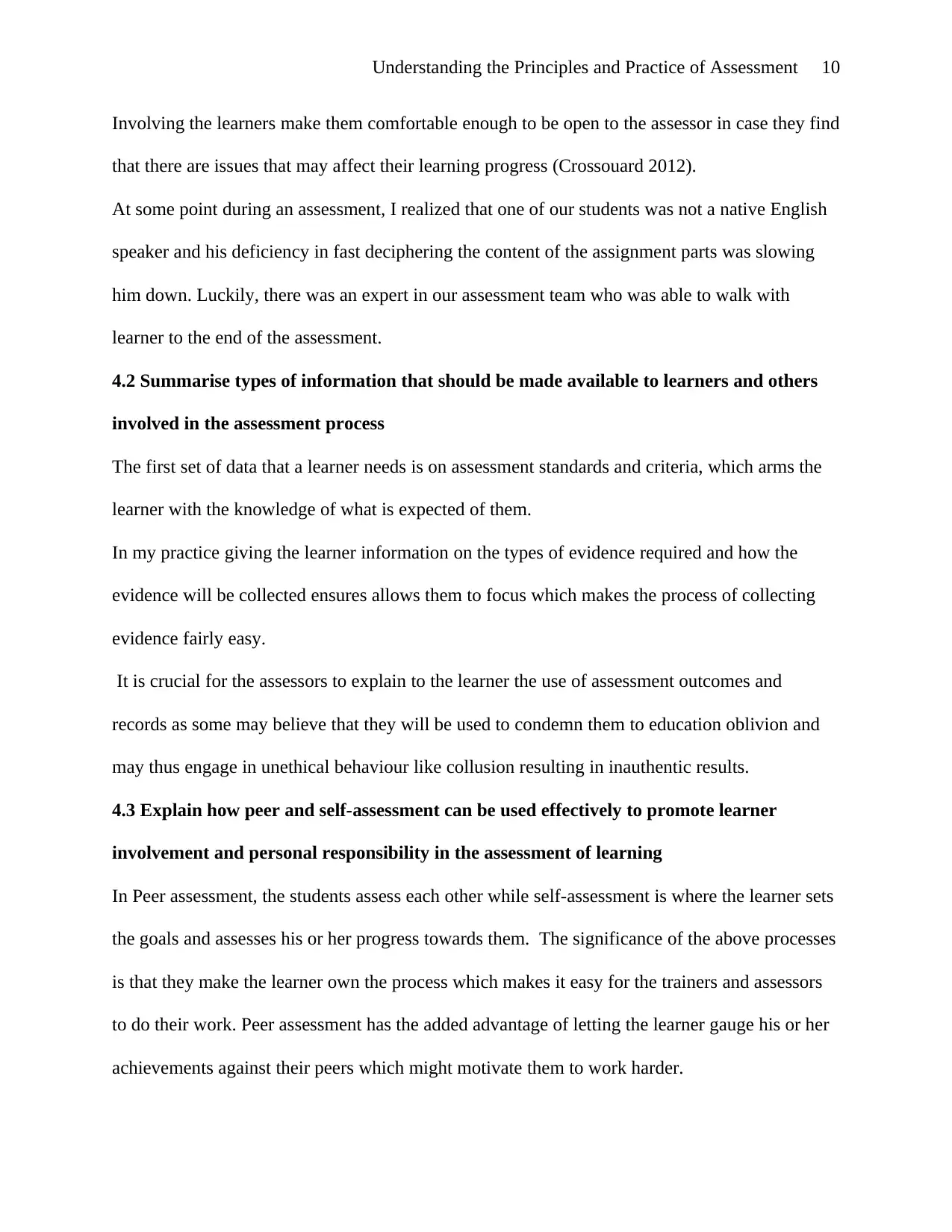
Understanding the Principles and Practice of Assessment 10
Involving the learners make them comfortable enough to be open to the assessor in case they find
that there are issues that may affect their learning progress (Crossouard 2012).
At some point during an assessment, I realized that one of our students was not a native English
speaker and his deficiency in fast deciphering the content of the assignment parts was slowing
him down. Luckily, there was an expert in our assessment team who was able to walk with
learner to the end of the assessment.
4.2 Summarise types of information that should be made available to learners and others
involved in the assessment process
The first set of data that a learner needs is on assessment standards and criteria, which arms the
learner with the knowledge of what is expected of them.
In my practice giving the learner information on the types of evidence required and how the
evidence will be collected ensures allows them to focus which makes the process of collecting
evidence fairly easy.
It is crucial for the assessors to explain to the learner the use of assessment outcomes and
records as some may believe that they will be used to condemn them to education oblivion and
may thus engage in unethical behaviour like collusion resulting in inauthentic results.
4.3 Explain how peer and self-assessment can be used effectively to promote learner
involvement and personal responsibility in the assessment of learning
In Peer assessment, the students assess each other while self-assessment is where the learner sets
the goals and assesses his or her progress towards them. The significance of the above processes
is that they make the learner own the process which makes it easy for the trainers and assessors
to do their work. Peer assessment has the added advantage of letting the learner gauge his or her
achievements against their peers which might motivate them to work harder.
Involving the learners make them comfortable enough to be open to the assessor in case they find
that there are issues that may affect their learning progress (Crossouard 2012).
At some point during an assessment, I realized that one of our students was not a native English
speaker and his deficiency in fast deciphering the content of the assignment parts was slowing
him down. Luckily, there was an expert in our assessment team who was able to walk with
learner to the end of the assessment.
4.2 Summarise types of information that should be made available to learners and others
involved in the assessment process
The first set of data that a learner needs is on assessment standards and criteria, which arms the
learner with the knowledge of what is expected of them.
In my practice giving the learner information on the types of evidence required and how the
evidence will be collected ensures allows them to focus which makes the process of collecting
evidence fairly easy.
It is crucial for the assessors to explain to the learner the use of assessment outcomes and
records as some may believe that they will be used to condemn them to education oblivion and
may thus engage in unethical behaviour like collusion resulting in inauthentic results.
4.3 Explain how peer and self-assessment can be used effectively to promote learner
involvement and personal responsibility in the assessment of learning
In Peer assessment, the students assess each other while self-assessment is where the learner sets
the goals and assesses his or her progress towards them. The significance of the above processes
is that they make the learner own the process which makes it easy for the trainers and assessors
to do their work. Peer assessment has the added advantage of letting the learner gauge his or her
achievements against their peers which might motivate them to work harder.
Paraphrase This Document
Need a fresh take? Get an instant paraphrase of this document with our AI Paraphraser
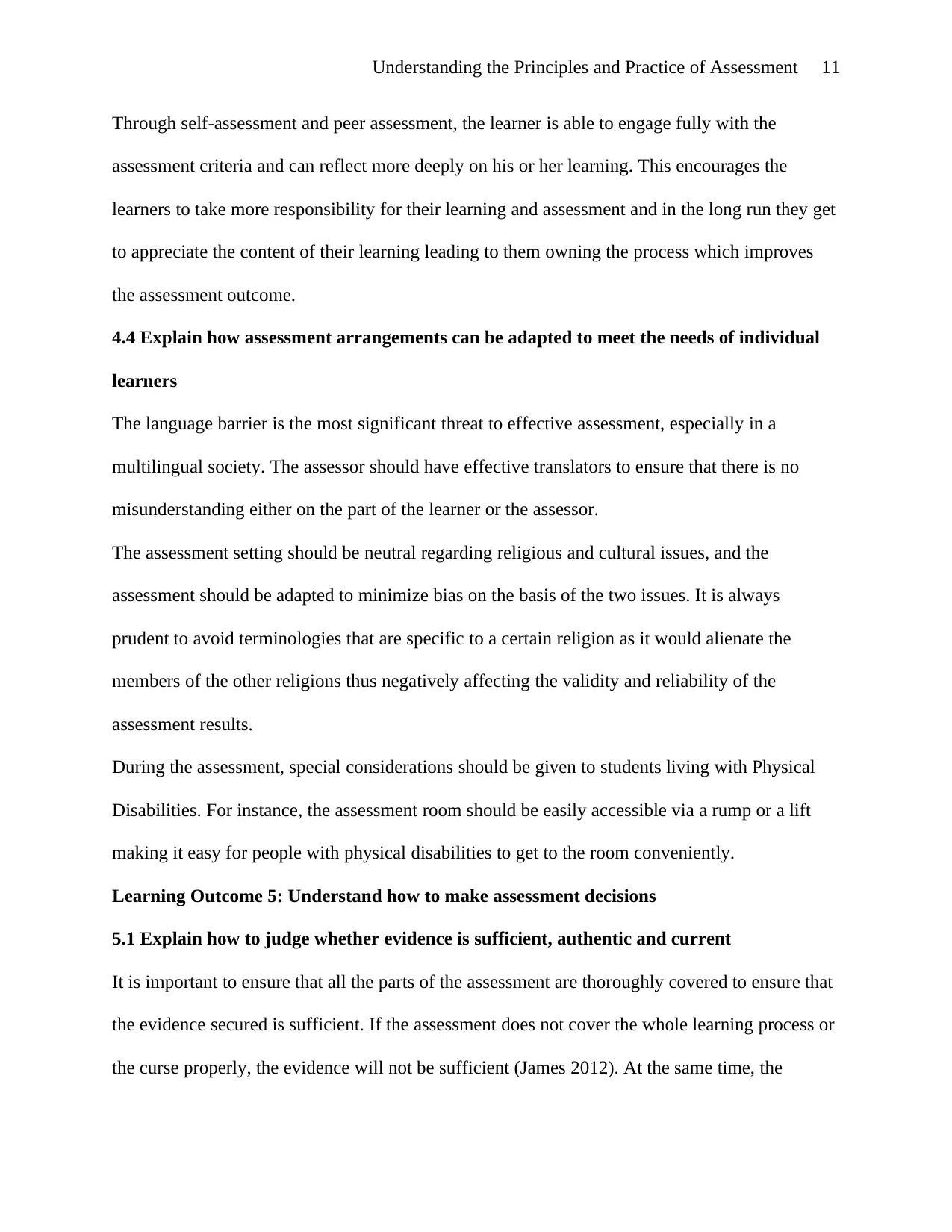
Understanding the Principles and Practice of Assessment 11
Through self-assessment and peer assessment, the learner is able to engage fully with the
assessment criteria and can reflect more deeply on his or her learning. This encourages the
learners to take more responsibility for their learning and assessment and in the long run they get
to appreciate the content of their learning leading to them owning the process which improves
the assessment outcome.
4.4 Explain how assessment arrangements can be adapted to meet the needs of individual
learners
The language barrier is the most significant threat to effective assessment, especially in a
multilingual society. The assessor should have effective translators to ensure that there is no
misunderstanding either on the part of the learner or the assessor.
The assessment setting should be neutral regarding religious and cultural issues, and the
assessment should be adapted to minimize bias on the basis of the two issues. It is always
prudent to avoid terminologies that are specific to a certain religion as it would alienate the
members of the other religions thus negatively affecting the validity and reliability of the
assessment results.
During the assessment, special considerations should be given to students living with Physical
Disabilities. For instance, the assessment room should be easily accessible via a rump or a lift
making it easy for people with physical disabilities to get to the room conveniently.
Learning Outcome 5: Understand how to make assessment decisions
5.1 Explain how to judge whether evidence is sufficient, authentic and current
It is important to ensure that all the parts of the assessment are thoroughly covered to ensure that
the evidence secured is sufficient. If the assessment does not cover the whole learning process or
the curse properly, the evidence will not be sufficient (James 2012). At the same time, the
Through self-assessment and peer assessment, the learner is able to engage fully with the
assessment criteria and can reflect more deeply on his or her learning. This encourages the
learners to take more responsibility for their learning and assessment and in the long run they get
to appreciate the content of their learning leading to them owning the process which improves
the assessment outcome.
4.4 Explain how assessment arrangements can be adapted to meet the needs of individual
learners
The language barrier is the most significant threat to effective assessment, especially in a
multilingual society. The assessor should have effective translators to ensure that there is no
misunderstanding either on the part of the learner or the assessor.
The assessment setting should be neutral regarding religious and cultural issues, and the
assessment should be adapted to minimize bias on the basis of the two issues. It is always
prudent to avoid terminologies that are specific to a certain religion as it would alienate the
members of the other religions thus negatively affecting the validity and reliability of the
assessment results.
During the assessment, special considerations should be given to students living with Physical
Disabilities. For instance, the assessment room should be easily accessible via a rump or a lift
making it easy for people with physical disabilities to get to the room conveniently.
Learning Outcome 5: Understand how to make assessment decisions
5.1 Explain how to judge whether evidence is sufficient, authentic and current
It is important to ensure that all the parts of the assessment are thoroughly covered to ensure that
the evidence secured is sufficient. If the assessment does not cover the whole learning process or
the curse properly, the evidence will not be sufficient (James 2012). At the same time, the
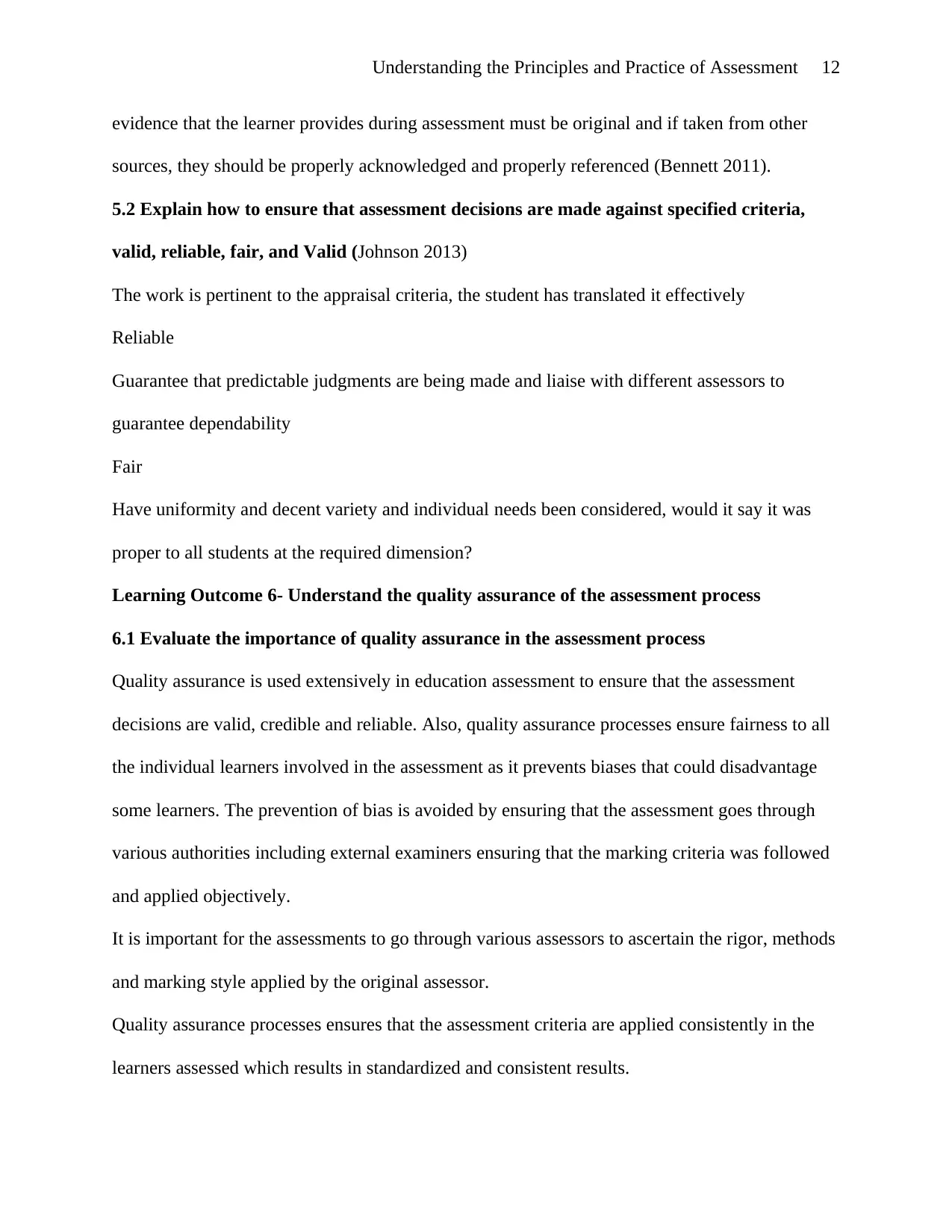
Understanding the Principles and Practice of Assessment 12
evidence that the learner provides during assessment must be original and if taken from other
sources, they should be properly acknowledged and properly referenced (Bennett 2011).
5.2 Explain how to ensure that assessment decisions are made against specified criteria,
valid, reliable, fair, and Valid (Johnson 2013)
The work is pertinent to the appraisal criteria, the student has translated it effectively
Reliable
Guarantee that predictable judgments are being made and liaise with different assessors to
guarantee dependability
Fair
Have uniformity and decent variety and individual needs been considered, would it say it was
proper to all students at the required dimension?
Learning Outcome 6- Understand the quality assurance of the assessment process
6.1 Evaluate the importance of quality assurance in the assessment process
Quality assurance is used extensively in education assessment to ensure that the assessment
decisions are valid, credible and reliable. Also, quality assurance processes ensure fairness to all
the individual learners involved in the assessment as it prevents biases that could disadvantage
some learners. The prevention of bias is avoided by ensuring that the assessment goes through
various authorities including external examiners ensuring that the marking criteria was followed
and applied objectively.
It is important for the assessments to go through various assessors to ascertain the rigor, methods
and marking style applied by the original assessor.
Quality assurance processes ensures that the assessment criteria are applied consistently in the
learners assessed which results in standardized and consistent results.
evidence that the learner provides during assessment must be original and if taken from other
sources, they should be properly acknowledged and properly referenced (Bennett 2011).
5.2 Explain how to ensure that assessment decisions are made against specified criteria,
valid, reliable, fair, and Valid (Johnson 2013)
The work is pertinent to the appraisal criteria, the student has translated it effectively
Reliable
Guarantee that predictable judgments are being made and liaise with different assessors to
guarantee dependability
Fair
Have uniformity and decent variety and individual needs been considered, would it say it was
proper to all students at the required dimension?
Learning Outcome 6- Understand the quality assurance of the assessment process
6.1 Evaluate the importance of quality assurance in the assessment process
Quality assurance is used extensively in education assessment to ensure that the assessment
decisions are valid, credible and reliable. Also, quality assurance processes ensure fairness to all
the individual learners involved in the assessment as it prevents biases that could disadvantage
some learners. The prevention of bias is avoided by ensuring that the assessment goes through
various authorities including external examiners ensuring that the marking criteria was followed
and applied objectively.
It is important for the assessments to go through various assessors to ascertain the rigor, methods
and marking style applied by the original assessor.
Quality assurance processes ensures that the assessment criteria are applied consistently in the
learners assessed which results in standardized and consistent results.
⊘ This is a preview!⊘
Do you want full access?
Subscribe today to unlock all pages.

Trusted by 1+ million students worldwide
1 out of 20
Related Documents
Your All-in-One AI-Powered Toolkit for Academic Success.
+13062052269
info@desklib.com
Available 24*7 on WhatsApp / Email
![[object Object]](/_next/static/media/star-bottom.7253800d.svg)
Unlock your academic potential
Copyright © 2020–2025 A2Z Services. All Rights Reserved. Developed and managed by ZUCOL.



